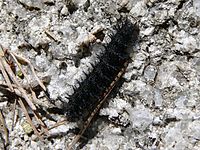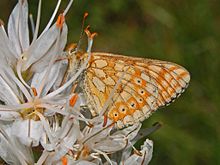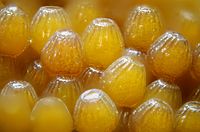- Marsh Fritillary
-
Marsh Fritillary 
Euphydryas aurinia, northern Portugal Scientific classification Kingdom: Animalia Phylum: Arthropoda Class: Insecta Order: Lepidoptera Family: Nymphalidae Genus: Euphydryas Species: E. aurinia Binomial name Euphydryas aurinia
(Rottemburg, 1775)The Marsh Fritillary, Euphydryas aurinia, is a butterfly of the Nymphalidae family.It is widespread in the Palaearctic region from Ireland in the West to Yakutia in the East, and to North-west China and Mongolia in the South.E. aurinia is represented by many subspecies. The most widely accepted are:
- E. a. bulgarica (Fruhstorfer, 1916) Carpathian Mountains
- E. a. laeta (Christoph, 1893) Central Siberia, Altai, Sayan, Transbaikal
- E. a. beckeri (Lederer, 1853) Morocco (Middle Atlas, Rif Mountains)
- E. a. barraguei (Betz, 1956) Algeria
but the total number of described subspecies is much higher especially in the Eastern Palaearctic.The insect may be best considered a superspecies.
The larvae are recorded as feeding on Succisa pratensis and species of Digitalis, Plantago,Veronica (V.dubravnaya, etc.), Geranium,Sambucus, Gentiana, Valeriana, Lonicera, Filipendula, Spiraea and Viburnum.
Contents
The Marsh Fritillary in the British Isles
The Marsh Fritillary is in decline in Europe and one of 11 butterflies covered by the United Kingdom Biodiversity Action Plan. Within the British Isles, it is more frequent in the south and west.[1]
The adult butterflies are marked in checkered marking of gold and brown with a black background. The underside of the wings is patterned with yellow orange and black without any silver coloration at all. The eggs are yellow identified by being in a large batch,and the larvae are black.
The Marsh Fritillary is usually to be found in damp heathy grasslands which are called rhos pastures from the Welsh word rhos meaning heath, but the species does exist in other types of habitats which are drier, like neutral grasslands or dry calcareous grasslands. Small populations may be seen where there is not a lot of the larval foodplant present. Small populations can be an important element of the ecology because they can produce lots of mobile individuals which can found other populations.
The Marsh Fritillary is protected under British Law. It is listed under Schedule 5 of the Wildlife and Countryside Act, also the EU Habitats and Species Directive (Annex II).
The butterflies fly from the April until July depending on latitude and altitude.
Habitats
- Damp and heathy grassland, dominated by tussock forming grasses, including Purple Moor and Rush Pastures
- Calcareous grassland
- Temporary colonies - woodland clearings and other grasses
Food plants
The main food plant of the Marsh Fritillary is the Devil's bit scabious, Succisa pratensis, but can also include the field scabious Knautia arvensis and the small scabious Scabiosa columbaria.
Life cycle
The eggs are laid in groups on the underside of the leaves in May and June. Up to 350 are laid in a single batch. They turn from pale yellow when first laid, turn bright yellow, then crimson, and finally to dark grey just prior to hatching. The caterpillars hatch from the end of June onwards. The young caterpillars live in communal webs that are spun across the foodplant and these become conspicuous by the end of August. In the autumn they make stronger webs, closer to the ground usually within a dense grass tussock, where they will start to hibernate. In the spring the caterpillars start to disperse from their communities after their last molt. They change colour from brown to black and may be occasionally seen basking in the sun. They need to be warm in order to eat. The caterpillars are liable to be attacked by the parasitoid wasp Apanteles bignellii, especially in warm spring weather[2]. Pupae form from mid April, low down deep within grass tussocks or dead leaves. Adults emerge from mid-June to mid July.
Metapopulations
Research work on the population dynamics of the Marsh Fritillary has shown that they live in metapopulations. A metapopulation is defined as a collection of local populations that are connected together as a result of occasional dispersal. Amongst these some will disappear and others will be founded.
Usually the Marsh Fritillary lives in small populations that tend to die out and new populations are founded from nearby sites. An important feature of metapopulations is that there will always be empty habitat within the system. It is possible for the majority of the habitat patches to be empty. The security of suitable places where the butterfly does not presently occur is essential to its survival in the long term.
Management
The aim is to produce an uneven patchwork of short and long vegetation by the end of the grazing period, between 8 and 25 cm. This is to allow the food plant to grow.
This can be achieved through:
- Low intensity grazing (also known as extensive grazing) using cattle. Sheep are not so good as they are more efficient at removing wild plants.
- Burning - not so good as may kill a proportion of Marsh Fritillary
Monitoring and indicators of success
- The frequency of larval webs in 3m strip can be counted during random walk of at least 100 paces in October - February. The larval web present in at least 30% of paces.
- Frequency of flowers (adult nectar sources) counted within 3m strip during random walk in May - June should be at least 50%
- Frequency of Succisa pratensis (larval foodplant) counted within 3m strip during a random walk of at least 100 paces. Succisa pratensis in at least 80% of paces. No more than 25% reduction in abundance
- Average height of sward measured by drop disc or by estimation. There should be a mosaic of sward heights of between 8 – 20 cm during May - September
- Sward structure monitoring. The butterflies require varied habitat structure: basking sites, supplies of nectar, roosting area.
Example sites
The Devon Wildlife Trust owns a number of sites for which it monitors this species. Examples include Stowford Moor (near Holsworthy, Devon), Dunsdon nature reserve (near Bude), Mambury Moor (near Great Torrington), Vealand Farm nature reserve (near Holsworthy), Volehouse Nature Reserve (near Holsworthy). In 2009, counts of number of species had significantly increased from years 2007 and 2008.[3]
External links
- Marsh Fritillary in the UK Biodiversity Action Plan.
- Butterfly Conservation run a project devoted to the conservation of this butterfly.
- Marsh Fritillary Fact sheet on how to manage sites
- UK Butterfly organisation description on this species
- Devon Wildlife Trust manages a number of strongholds for the species including Volehouse Moor, Dunsdon, Meshaw Moor and Vealand farm
- McKee, L. 2008. "Bid to halt decline of butterfly." Belfast Telegraph. 18 July 2008. p. 10 (www.belfasttelegraph.co.uk)
- JNCC website: SAC selection, Annex II Species Accounts
References
- ^ NBN gateway: Euphydryas aurinia
- ^ http://www.learnaboutbutterflies.com/Britain%20-%20Euphydryas%20aurinia.htm
- ^ Wild Devon The Magazine of the Devon Wildlife Trust,page 8 Winter 2009 edition
Categories:- Euphydryas
- Butterflies and moths of Europe
- British butterflies
- Animals described in 1775
Wikimedia Foundation. 2010.






